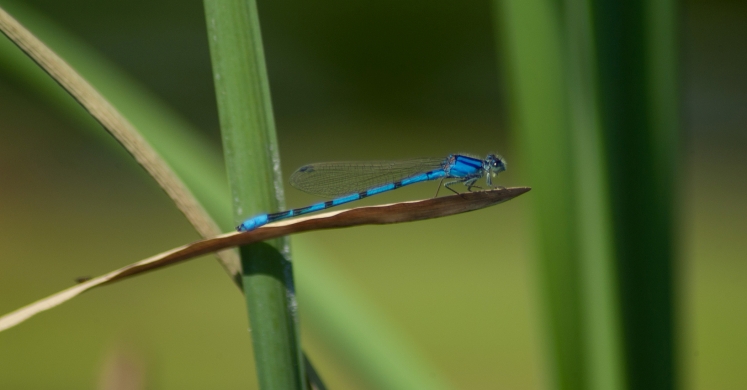Blog

#bioPGH Blog: Damselflies
 A resource of Biophilia: Pittsburgh, #bioPGH is a weekly blog and social media series that aims to encourage both children and adults to reconnect with nature and enjoy what each of our distinctive seasons has to offer. From the best times to plant seasonal flora and enjoy their peak blooms, to astronomical events and creatures to keep an eye and ear out for, Phipps will keep you in the know with what’s going on in our environment!
A resource of Biophilia: Pittsburgh, #bioPGH is a weekly blog and social media series that aims to encourage both children and adults to reconnect with nature and enjoy what each of our distinctive seasons has to offer. From the best times to plant seasonal flora and enjoy their peak blooms, to astronomical events and creatures to keep an eye and ear out for, Phipps will keep you in the know with what’s going on in our environment!
Is that a dragonfly? It’s the same shape, but it’s brightly colored and much narrower — nope! It’s a damselfly! These insects that buzz around water bodies in close proximity to dragonflies may look similar, but they are quite different. Both insects belong to the order Odonata, but damselflies fall into the suborder Zygoptera, dragonflies in the suborder Anisoptera. Aside from appearing smaller and slimmer, damselflies fold their wings back above their bodies when resting. When dragonflies rest, their wings are flat and perpendicular to their bodies. You can find damselflies in a neon version of almost every color of the rainbow, such as the Violet Dancer (Argia fumipennis violacea), the brightly-striped Doubleday’s Bluet (Enallagma doubledayii), or the aptly-named American Ruby Spot (Hetaerina americana).
Damselflies have two life stages, the nymphal and adult stage. Nymphs are aquatic, spending most of their time at the bottom of freshwater lakes, streams, and rivers, feeding on small aquatic insects. They breathe through blade-like gills located at the tip of their abdomen. What does this mean? They breathe through their butts! As nymphs, they go through 10 – 12 immature stages, called instars. When they finally molt into adults, the nymphs crawl up on land, leaving behind an exoskeleton, and emerge as a colorful adult damselfly.
Adult damselflies live between a few weeks to a few months, so females have a short window of time in which to mate and lay eggs. Adult male damselflies establish territories to entice females, and will chase other males away. You may see two attached damselflies flying through the air in tandem – this is a mating damselfly pair. After copulation, the female will submerge herself in a pond or stream to deposit her eggs within the soft tissue of a plant stem, all the while trying to avoid predators like birds, fish, and frogs.
Damselflies and dragonflies ruled the skies long before birds – fossil specimens exist for both suborders. During the Carboniferous period, when oxygen levels were much higher than they are now, some species of Meganeura, a genus of extinct insects that were ancestors of the present-day Odonata, had wingspans of more than two feet — the size of a modern-day pigeon!
Connecting to the Outdoors Tip: You can find damselflies buzzing around the lagoon in the Center for Sustainable Landscapes at Phipps, or around the many streams, rivers and ponds throughout the Pittsburgh area. On July 30th, teens and adults can ”snorkel the Clarion” in Cook Forest State Park to look for aquatic invertebrates and fish. This would be a great opportunity to see damselfly and dragonfly nymphs along with other underwater creatures.
For those who can’t go snorkeling, there are a number of damselfly crafts that can be made at home. Little ones can make this simple wooden spoon craft, and for older crafters, a damselfly embroidery tutorial can be found here.
Continue the Conversation: Share your nature discoveries with our community by posting to Twitter and Instagram with hashtag #bioPGH, and R.S.V.P. to attend our next Biophilia: Pittsburgh meeting.
Additional Resources:
"Zygoptera Species" | Google Image Search
Center for Sustainable Landscapes | Phipps Conservatory and Botanical Gardens
Snorkeling the Clarion | | PA Department of Conservation and Natural Resources
Make the Coolest Wooden Spoon Bugs Ever | Handmade Charlotte
Embroidering Damselflies Tutorial | Free Craft Articles
How to Tell the Difference Between a Dragonfly and a Damselfly | Mother Nature Network
Damselflies | BBC Nature
Order Odonata | BugGuide
Select photos © Paul g. Wiegman

